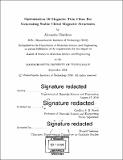Optimization of magnetic thin films for generating stable chiral magnetic structures
Author(s)
Churikova, Alexandra
DownloadFull printable version (14.99Mb)
Other Contributors
Massachusetts Institute of Technology. Department of Materials Science and Engineering.
Advisor
Geoffrey S. D. Beach.
Terms of use
Metadata
Show full item recordAbstract
The field of spintronics, or the use of electron spin for information processing, has revolutionized information storage. The long-term stability, low energy and low current in magnetic devices make them attractive for memory storage, sensors and computing. Their effectiveness is limited by the current, density, and device size, which can be optimized by tuning the magnetic materials properties. In this thesis, we show the effectiveness of ferromagnetic materials for the stability of magnetic "bits" numerically, and provide experimental insight into the engineering of material properties of ferrimagnetic and antiferromagnetic films. Skyrmions are topologically protected chiral spin structures that are highly promising candidates for magnetic bits due to their stability and potential for fast motion. These spin structures can be used to encode O's and l's in racetrack memory devices. Chiral domain walls and skyrmions have been studied in magnetic thin films sandwiched between non-identical non-magnetic materials which have high spin-orbit coupling and Dzyaloshinskii-Moriya interaction (DMI). Parameters such as layer thicknesses and composition can be tuned for optimal skyrmion stability, speed, and size. We use micromagnetic simulations to confirm experimental studies where skyrmions have been annihilated systematically with out-of-plane applied fields in the presence of in-plane fields. We show that in-plane magnetic field deforms the skyrmion and its domain wall, increasing the domain wall size and domain wall energy. This effect has been found to be greater in stray-field stabilized skyrmions with zero DMI. We subsequently image ultrasmall skyrmions (of diameters approaching 10 nm) in ferri-magnetic material with a compensated magnetic moment, using a pump-probe X-ray holography technique. Finally, we develop a recipe for synthetic antiferromagnetic materials with perpendicular magnetic anisotropy that have the potential to host skyrmions and detected with X-ray holography imaging.
Description
Thesis: S.M., Massachusetts Institute of Technology, Department of Materials Science and Engineering, 2018. Cataloged from PDF version of thesis. Includes bibliographical references (pages 93-99).
Date issued
2018Department
Massachusetts Institute of Technology. Department of Materials Science and EngineeringPublisher
Massachusetts Institute of Technology
Keywords
Materials Science and Engineering.